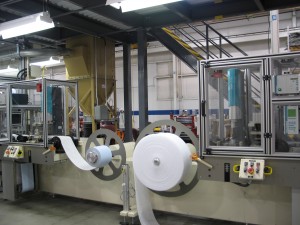Web Handling

As I mentioned in my previous post, this week I am in Tucson again on a 3 week job assignment. I was supposed to be here Wednesday but ended up getting a short trip to Casa Grande added at the last minute. Since I was working on a web line I thought I’d post a little bit on web handling in general.
A Web is a continuous piece of material such as paper, fabric or some extruded product. It is typically moved using rollers, which may apply tension, heating, cooling or some other process variable to the material. Between processing stages, webs are stored and transported as rolls also known as coils, packages and doffs. The end result or use of web manufacturing is usually sheets.
The primary motivation to work with webs instead of sheets is economics. Webs, being continuous, can be made at far higher speeds and do not have the start-stop issues of discrete sheet processing. Web handling is the art and science of getting a web through a machine with maximum productivity and minimum waste.
Converting is the process of combining raw materials such as polyesters, adhesives, silicone, tapes, foams, plastics, felts, rubbers, liners and metals, as well as other materials, to create new products. Materials such as paper, plastic film, foil and cloth often are produced in long, continuous sheets that are rolled up for more-convenient handling and transportation. These rolls of material vary significantly in size and weight, ranging from 2 to 200 in. wide and weighing as much as several tons. The converting industry takes these continuous rolls of thin, flat materials or webs, threads them though processing machines (such as printing presses, laminating, coating and slitting machines) and converts or changes the web of material into an intermediate form or final product. For example, a converter’s equipment might take a web of plastic film, cut it into lengths, and fuse their edges, thus converting it into plastic bags. This activity is known as web processing.
Web alignment is an important part of a converting operation as a moving web of material has a tendency to track off course and wander out of alignment during converting processes. To avoid these problems, engineers have developed a variety of automatic web-guiding systems that assure production accuracy and reduce waste. Web-guiding systems typically are positioned just before a critical stage on a converting machine (for example, just before a print station on a printing press).
There are many different kinds of standard machines available to assist in web converting and handling. Winders, Unwinders, Automatic Splicers and Accumulators are all examples of machines that can be purchased as a standard machine. Rollers of various types are also easily ordered as a standard or custom product.
Because of the availability of all of these different kinds of standard components and machines, web lines are a great example of integration. A complete line can often be formed entirely from purchased items, a frame and a control system. Subassemblies like adhesive or printing systems may then be used as part of the converting process.
My task this week was to integrate an accumulator, purchased as a complete system from a vendor, into an existing web line. As with many such applications, this one will unfortunately probably involve several more trips. It was 107 degrees in Casa Grande on Tuesday. Maybe I can delay it until December?

i have read a research paper whch was published on 2006 , it say that currently (2006) there are no specific protocol to handle messages communications between AJAX and Web Services. So i am wondering if this case is still valid or there are currently such protocols?
thanks